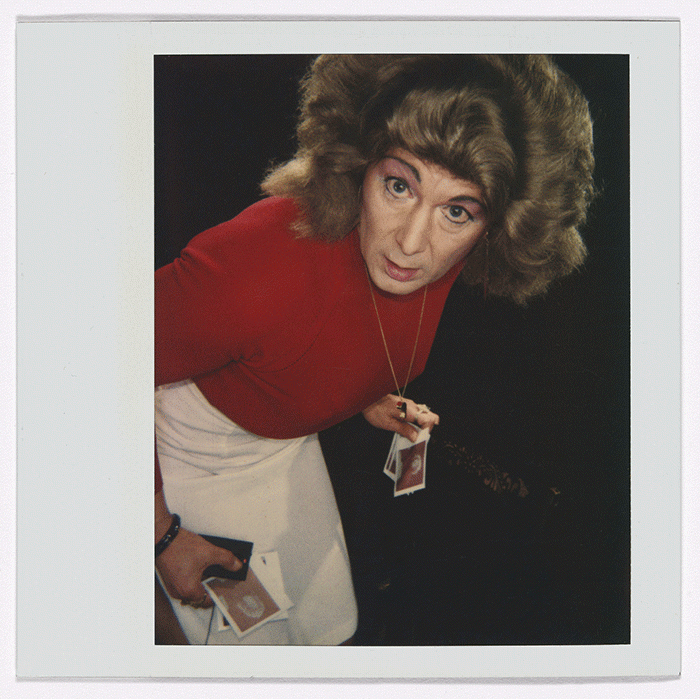It takes a moment for the impact of these Polaroid self-portraits to register, given that each is no larger than the palm of your hand. Step closer, look more intently, and you’ll be met by an astonishing artistic vision. April Dawn Alison was the private persona of an Oakland-based commercial photographer known to familiars as Alan Schaefer (1941–2008). Her public debut is drawn from a collection of more than 9,200 photographs, virtually all of them self-portraits, taken over more than 30 years and discovered on the artist’s death by artist Andrew Masullo, who purchased them from an estate liquidator and donated them to SFMOMA. Together, they chart the evolution of April Dawn Alison, into whose frippery and face-paint Schaefer slipped after hours, and always in secret.
A horizon line of clustered frames – some containing single images, others thematic groupings arranged in grids – illustrate three decades of exploration, experimentation and exultant self-actualisation. Indeed, Alison is often pictured holding other Polaroids of herself, as if caught in the act of witnessing her own inception. Polaroids offer instant gratification but also, crucially, privacy (no one else would be developing the film). While the photographs were left undated, and largely unsigned, there is an implicit chronology to the display: we begin with a more tentative black- and-white Alison, captured on the earlier and more beautiful Polaroid film, her transformation limited to a wig and falsies. From the late 1960s, Alison gains in confidence and panache, her set-ups diversify, grow increasingly narrative and, in a series of bondage-themed images, veer into gymnastic terrain. The choice of environment and costume is often droll, more William Wegman than William Eggleston: standing, back to the camera, amidst the strewn streamers of an empty party; a housewife surrounded by domestic paraphernalia; a French maid smoking. Alison collected wigs, loved clothes, favoured high heels.
The material fluency doesn’t come as a surprise – Schaefer would have used Polaroids to check composition or lighting in his commercial work. Still, it’s impossible to know to what degree Alison was aware of queer predecessors like Claude Cahun or Pierre Molinier, whose photograph Les jambes de Jean Meunier (1972) finds echo in Alison’s many fetishised, stockinged legs. Likewise, the drama of Alison’s poses, their implicit narrative and conflation of artist and subject recall the auto-scrutinising work of Cindy Sherman in the 1970s. Then there’s Andy Warhol in drag in 1981 or Robert Mapplethorpe in bondage in 1974. Whether or not Alison was looking outside for inspiration, she had a keen understanding of what makes a good picture.
An arresting sense of humour prevails: many images show Alison posed on her back, legs splayed, feet in the air, her face contorted in mock horror or feigned surprise. Others show her from behind, as if their creator were eager to see how she appeared to the world: svelte waist, shapely legs, form-fitting skirts, a mane of freshly brushed hair – a woman, unmistakably. The question of whether these images ought to have been displayed given the private nature of their production has dominated the discourse surrounding this exhibition, but risks eclipsing the work itself. What is most striking about April Dawn Alison is that she could – in private and with no expectation of display – be so committed to her art as to leave behind a repository so vast, compelling and provocative.
April Dawn Alison, SFMOMA, San Francisco, 6 July – 1 December 2019
From the January & February 2020 issue of ArtReview
